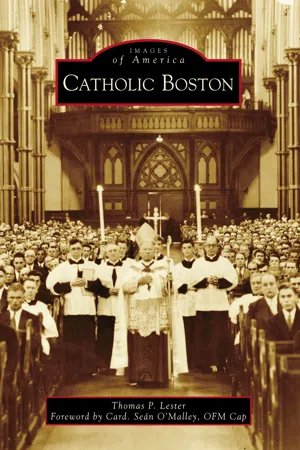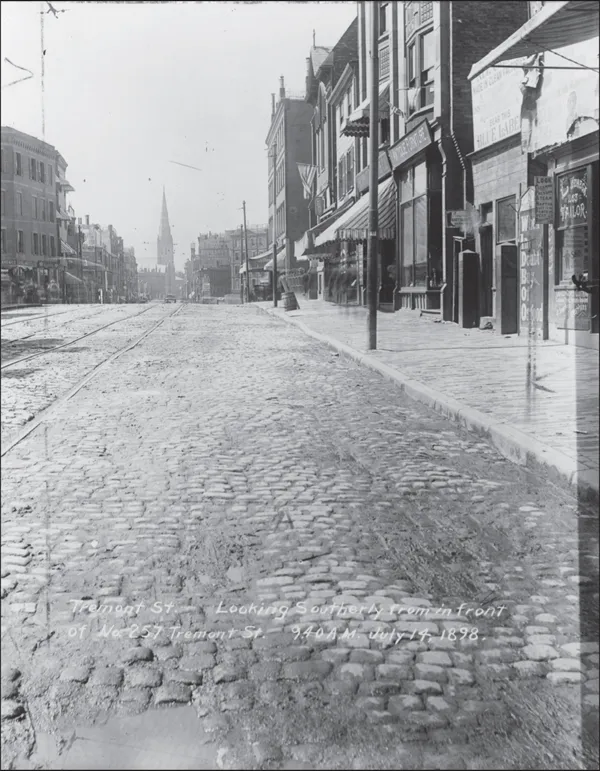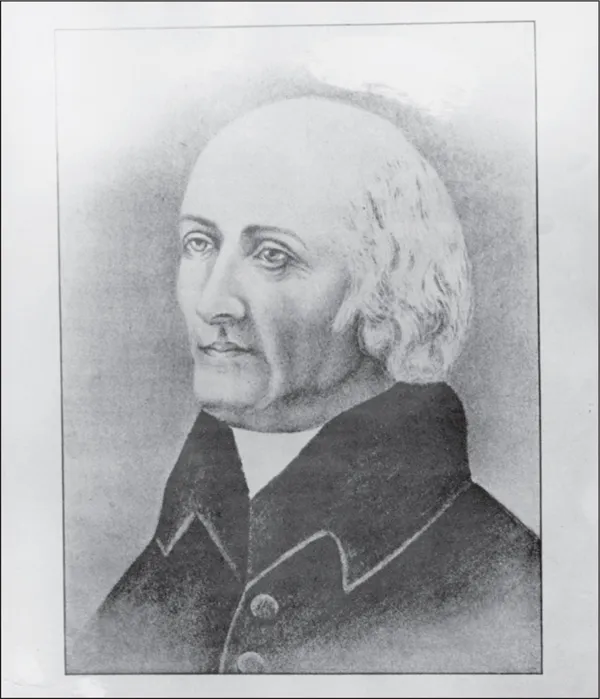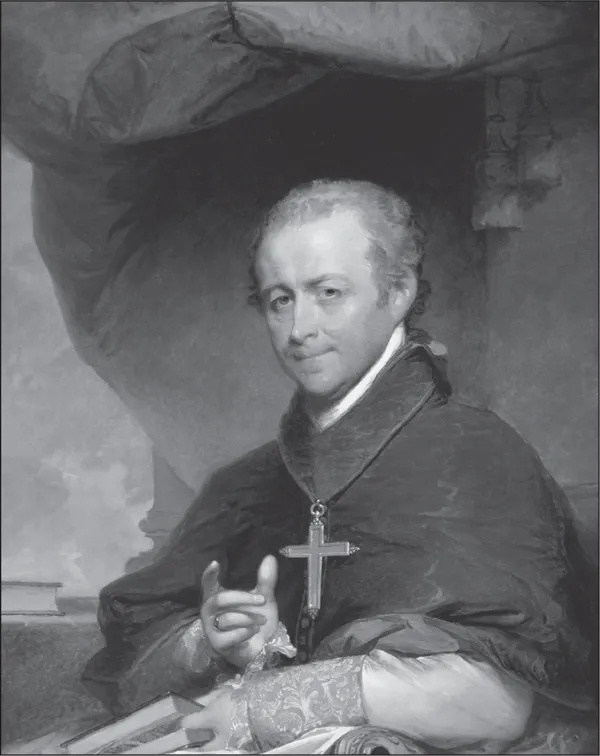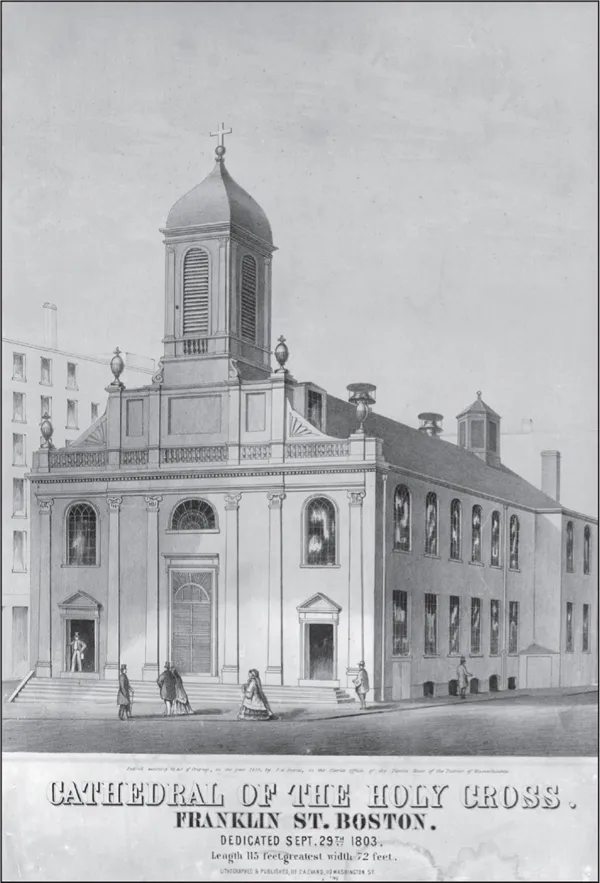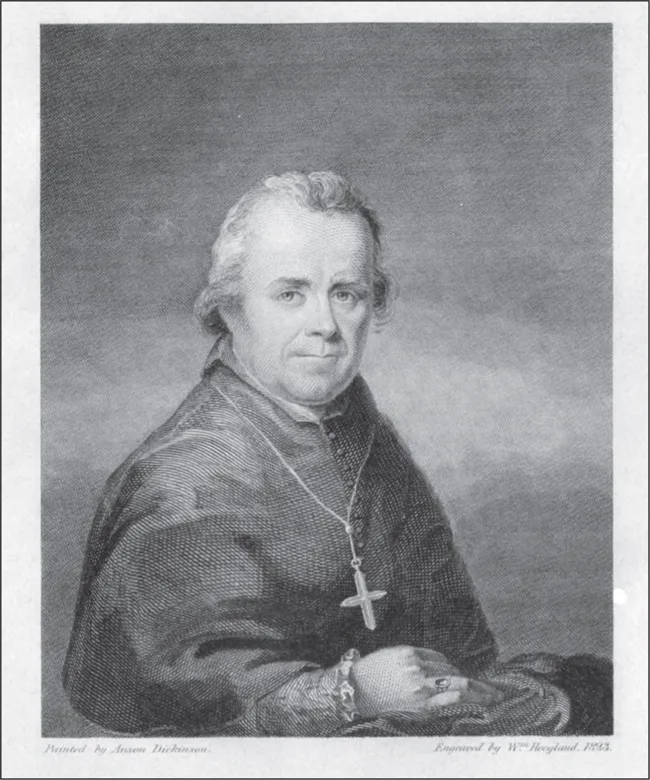![]()
One
A BRIEF HISTORY OF
CATHOLICISM IN BOSTON
This July 14, 1898, photograph shows Tremont Street in Boston. In the distance rises the spire of Holy Trinity Catholic Church, located on Shawmut Avenue. Today, as in 1898, Boston is synonymous with the Catholic community that resides there. Strange as it may seem, that was not always the case, as the earliest Catholics were outsiders in a region steeped in Puritan tradition. (Courtesy of The Pilot.)
The changing sentiments of 18th-century Bostonians toward Catholics are well represented by John Adams. Like many, he was suspicious of Catholics because of a perceived susceptibility to influence from Rome, but his opinion changed as the American Revolution took shape. He met Catholic patriots—and even attended a Catholic Mass—while in Philadelphia with the Continental Congress. There were also political considerations, as the British colonies courted both Canada and France as potential allies. Exposure and necessity had changed his views by the time he was elected as a delegate to the Massachusetts Constitutional Convention, which met on September 1, 1779. Adams would be the primary author of the Declaration of Rights, and Article II of the document offered freedom to worship any religion a citizen chose, assuming it did not disturb the public peace or inhibit another from doing so. (Courtesy of the Massachusetts State Archive, Boston.)
Originally holding services in private homes, the Abbé Claude de la Poterie presided at the first public Catholic Mass on November 2, 1788. The abbé, whose real name was Claude Florent Bouchard, arrived with a French fleet that anchored in Boston Harbor from August 28 to September 28, 1788, remaining in the city after its departure. The Mass was held in a former Huguenot chapel (the building on the left with the archways), most recently used by Congregationalists, located at 18 School Street, across from the former city hall. In a moment that would resonate throughout time, the abbé exposed a piece of the True Cross for veneration, thus giving that church, and all future iterations, including today’s cathedral, the name Holy Cross. Today, a plaque on the building marks the occasion. (Courtesy of the Knights of Columbus Museum, New Haven, Connecticut.)
The Diocese of Baltimore was created on November 6, 1789, and Fr. John Carroll (pictured) was appointed its first bishop. The diocese’s boundaries matched those of the new United States, whose first president, George Washington, was inaugurated in April of the same year. With such a vast geographic area to oversee, Bishop Carroll urged Rome to create additional dioceses to better serve the Catholics living there.
Bishop Carroll sent Fr. Francis Matignon to serve the Catholics in Boston who were split over their loyalty to two priests there. He arrived on August 20, 1792, and immediately repaired the fractured community. Over time, he improved relations with the non-Catholic community, oversaw construction of the first Catholic church in New England, and invited a fellow Frenchman, Fr. Jean Cheverus, to help him serve Catholics in that region.
Fr. Jean Cheverus arrived in Boston on October 3, 1796. Contemporaries commented on his pious nature, captivating speaking skills, and energy with which he went about his work. When the Diocese of Boston was created in 1808, he became its first bishop. This portrait, by American painter Gilbert Stuart, was commissioned in 1823, shortly before Bishop Cheverus returned to his native France. (Courtesy of the Museum of Fine Arts, Boston.)
In the autumn of 1799, Father Matignon purchased land on Franklin Street, Boston. The purchase, and his intention to build a new church for Boston’s burgeoning Catholic population, was announced on Christmas Day of that year. Charles Bullfinch, who had designed the recently completed Massachusetts State House and would later work on the US Capitol, was contracted to design it.
It was with great sadness that Bostonians learned of Father Matignon’s death on September 15, 1818. After a funeral Mass at the Franklin Street cathedral, he was temporarily laid to rest at the Granary Burying Ground, but Bishop Cheverus desired a more befitting resting place for his dear friend and colleague. In November 1818, the city approved his request to purchase land for a Catholic cemetery, which he did the following month. Father Matignon’s body was reinterred at the new location, St. Augustine Cemetery, and the following year a chapel was constructed over the spot where he lay, dedicated on July 4, 1819. At various points in time, Mass was regularly celebrated at the chapel until 1871, when the nearby St. Augustine Church was completed. Above, the chapel stands among the gravestones in the cemetery, and at right, markers in the floor indicate those who have been buried underneath the chapel. The chapel is still in use today. (Both, courtesy of The Pilot.)
In 1823, Bishop Cheverus departed Boston for his native France and served as bishop of Montauban in 1824 and archbishop of Bordeaux in 1826. A decade later, he was named a cardinal but died on July 19, 1836, at the age of 68, before being ordained as such. This print, produced in Paris the same year, shows a much older Cardinal Cheverus in vestments reflecting his new status.
Following Bishop Cheverus’s departure, it was unknown whether he would return until November 30, 1825, when his successor, Bishop Benedict Joseph Fenwick, arrived in Boston. He is described as being nearly six feet tall and having a large frame, dark complexion, and thick curly hair with an honest appearance. An extrovert, Bishop Fenwich was known for his wit.
During a visit to Hartford, Connecticut, Bishop Fenwick met with Francis Taylor, who founded a Catholic newspaper there titled the Press. Inspired, Bishop Fenwick returned to Boston determined to start a Catholic newspaper of his own and succeeded when The Jesuit, or Catholic Sentinel, appeared on September 5, 1829. The purpose of this weekly publication was to “explain, diffuse and defend the Principles of the ONE, HOLY, CATHOLIC, and APOSTOLIC CHURCH.” It appeared under several titles in the ensuing two decades, including the United States Catholic Intelligencer, the Literary and Catholic Sentinel, the Boston Pilot, and The Pilot, the latter of which it has retained since 1858. The inaugural issue stated that any surplus profits would be directed toward “the establishment of a Roman Catholic Asylum in Boston, or its immediate vicinity, for the maintenance and education of poor Catholic children.” While the orphanage would eventually come into existence, the newspaper never achieved the financial stability to support such an endeavor. (Courtesy of Boston College Theology and Ministry Library, ...
